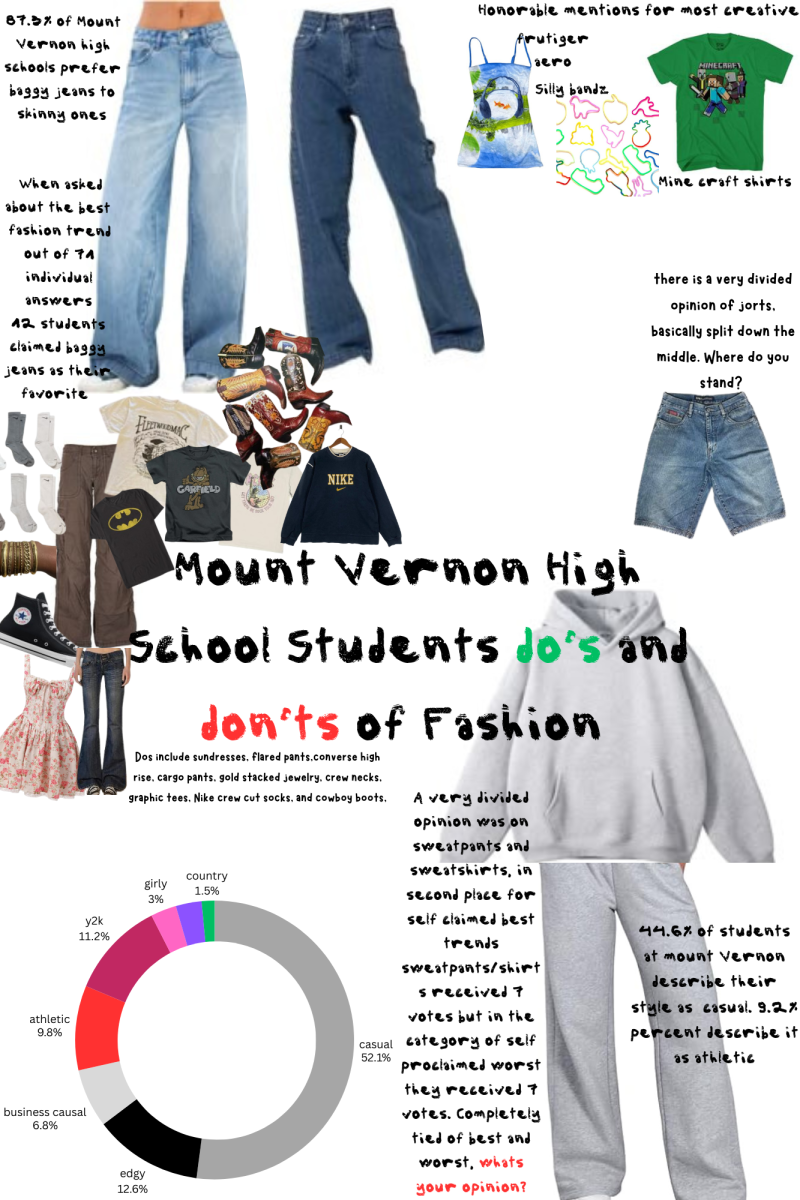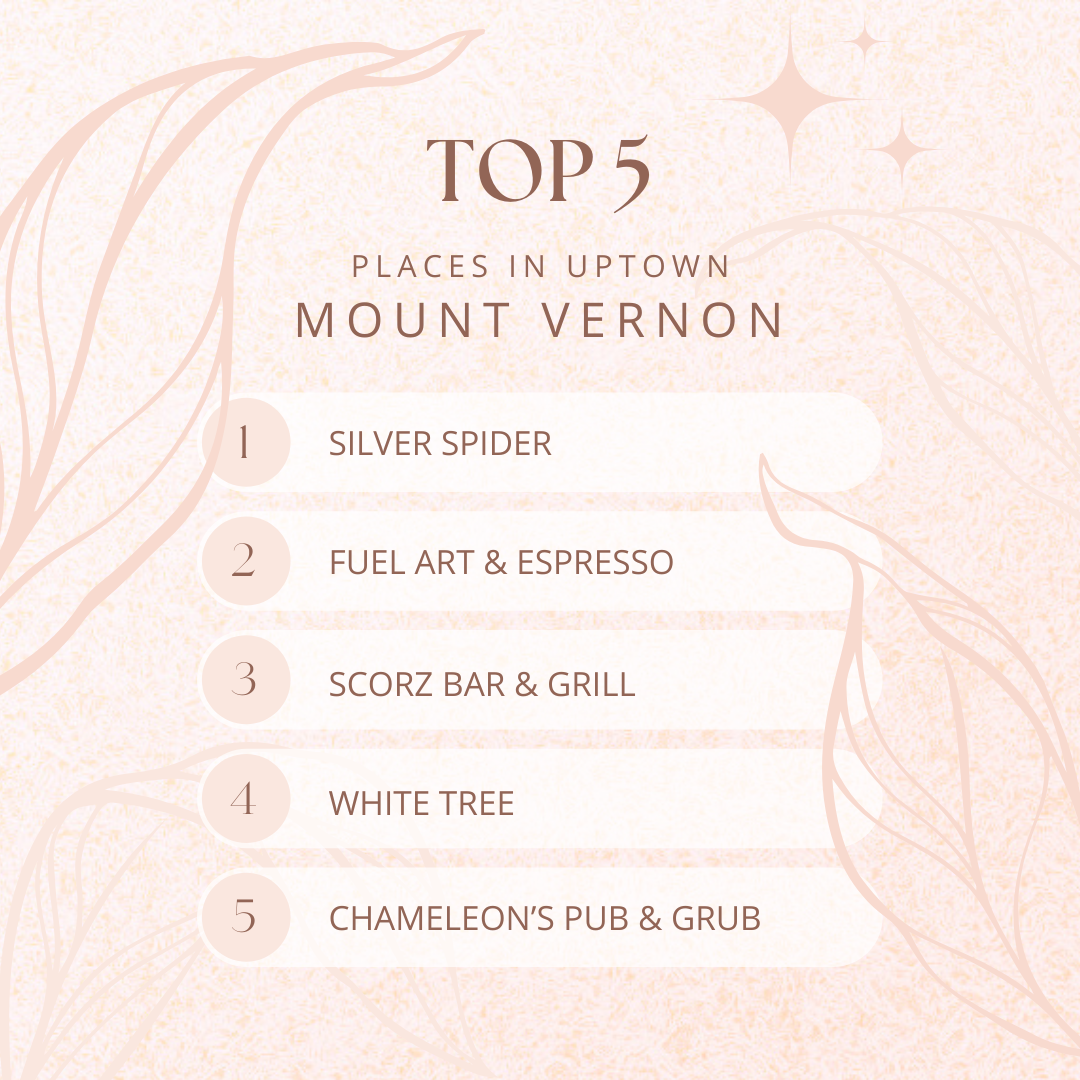Up and down the halls of Mount Vernon High School there are bustling teenagers with classes to go to, a sea of colors passing through. Blink and you’ll miss the unique styles and fads of this generation, time to take a deep dive into what’s ‘in’. Early April of 2025 Mount Vernon High School students received a survey entitled ‘Fashion Fads’, 72 students responded. Following are their insights into the Gen Z fashion opinions.
SKINNY JEANS OR BAGGY?
Unsurprisingly as seen in the media, students have an aversion to skinny jeans, 87.5% answering they prefer the baggier style of jeans, even going as far as nine separate responders claiming skinny jeans are the worst fashion trend. “Skinny jeans are not that bad, the problem is the ankles,” senior Sarabell Steil said. “When they are skinny and the ankles are tight, it’s not a look.”
COMFORTABLY:
Many responses led to the general idea of comfortably, 51.2% prefer the casual style, picking the best trends as things related such as sweatpants, sweatshirts, leggings, baggy pants, and crewneck sweaters. Comfortable attire leads the curve of the trends that students encounter daily, with 61.1% of people seeing shirts and jeans, 66.7% of people seeing athletic shorts and slides, 40.3% seeing cowboy boots, 34.7% seeing black clothes and band t-shirts, 23.6% seeing girlish pink flowery clothes.
On the very flip side, the responses for the worst trends also named leggings, sweatpants and pajamas. Do people find the low effort look unappealing and choose it anyway because of the easy grab-and-go style with the general acceptance of their peers opting for the same comfortable look? 94.4% of responders to the survey claim they see sweatpants and sweatshirts at school in their day to day life.
Alongside cowboy boots at eight people saying they are a bad trend, there were 10 separate and varying ideas of dislike for more scandalous clothes like short shorts, low cut sleeves, or low necklines.
HAIR:
Seven responses for worst fashion trends all separately made claims to different hairstyles, hair dye, buzz cuts, silk presses, low taper fades, utah curls and mullets are all spoken of as ‘bad trends’. What makes hair such a controversial topic? Polly Hinrichs, a junior, is unbothered by the state of other people’s hair, “Hair is just there, I wouldn’t label it as best or worst trend.” When learning what the disliked hairstyles are she finds she has opinions on buzz cuts “they (buzz cuts) make people look like an egg,” and for utah curls, “why not just curl your hair all the way down?” When asked if she finds the low effort look unappealing about these styles she disagrees, just finding the styles unflattering.
OUTFIT LAYOUT TRENDS AND FIT CHECKS
An anonymous responder describes a way of putting together outfits that is popular right now, sandwiching “color on top, different color, same color as the top on the bottom,” this shows an interesting development in not only clothing trends but also a name for the very way to build your outfits. As emerging there are more and more ideas alongside sandwiching that are becoming increasingly popular through social media and “fit checks.”
“Fit checks” are a widely common part of high school life today, where a person labels what they are doing out loud, claiming a “fit check” before twirling and stopping to lift their shoes into the eyeframe. Reaching its peak in 2017, a fit check is a way of saying “outfit” (fit) to “check out” (check).
There were a couple of outliers in the data, subcultures of people’s taste that were uncommon for the school but very much a trend in small groups of people. Most involved bringing back 2000s subcultures such as scene, Frutiger Metro, leopard print, cheetah print and some saying 2000s in general. Unrelated were unique childish suggestions like Silly Bandz and Minecraft T-shirts. Is the Gen Z regression to fashion styles popular when they were kids and styles more childish because of a nostalgic view of teenagers when they were young or is it just the cyclical repeat that happens every 20 years? UEN article The Potential of Cyclical Fashion written by Jorlee Tripp, describes how fashion has universally been repeated, the problem is while it started out with 300-400 year gaps between style repetition, like copying from 1500-1600s being used in the 1880s, then decreasing to 100 years between, like 1910s choosing styles from 1800s.
With the fashion gap between years so small and getting smaller companies can benefit by quickly and cheaply producing clothes that are very specific to the time period this leads to what is now known as ‘‘fast fashion’’. Because people don’t want or need clothes that hold quality for years, they don’t want to spend money on ethically made garments as they will be out of style soon anyway.







